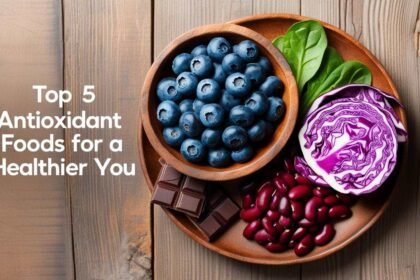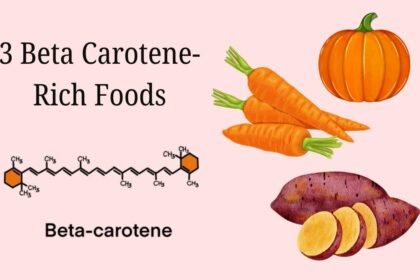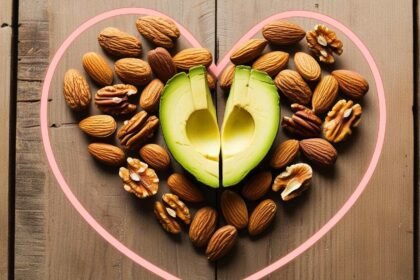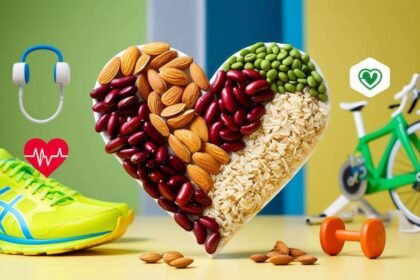More than half of the world’s population relies on rice as a staple food because it is one of the most widely consumed grains. Many nations’ diets still center around this adaptable grain, which has been farmed for almost 12,000 years.
Rice may seem like a simple carb, but it’s actually quite healthy because it’s loaded with vitamins, minerals, antioxidants, and other substances. Continue reading to find out more about rice’s amazing nutritional profile.
| Nutrient | White Rice (1 cup, cooked) | Brown Rice (1 cup, cooked) |
|---|---|---|
| Calories | 205 | 216 |
| Carbohydrates (g) | 45.1 | 44.8 |
| Protein (g) | 4.2 | 5.0 |
| Fat (g) | 0.4 | 1.8 |
| Fiber (g) | 0.6 | 3.5 |
| Sugar (g) | 0.1 | 0.4 |
| Vitamins and Minerals | ||
| Vitamin A (IU) | 0 | 0 |
| Vitamin C (mg) | 0 | 0 |
| Vitamin D (IU) | 0 | 0 |
| Vitamin E (mg) | 0 | 0.2 |
| Vitamin K (mcg) | 0 | 1.2 |
| Thiamin (B1) (mg) | 0.1 | 0.2 |
| Riboflavin (B2) (mg) | 0 | 0.1 |
| Niacin (B3) (mg) | 2.0 | 2.6 |
| Vitamin B6 (mg) | 0.2 | 0.3 |
| Folate (B9) (mcg) | 1 | 8.7 |
| Calcium (mg) | 15 | 19 |
| Iron (mg) | 0.7 | 0.8 |
| Magnesium (mg) | 19 | 83 |
| Phosphorus (mg) | 68 | 162 |
| Potassium (mg) | 55 | 84 |
| Sodium (mg) | 0 | 10 |
| Zinc (mg) | 0.6 | 1.2 |
| Copper (mg) | 0.1 | 0.2 |
| Manganese (mg) | 0.7 | 1.8 |
| Selenium (mcg) | 8.2 | 19.1 |
Calories and Macronutrients
White rice, when cooked, contains 130 calories, 2.7 grams of protein, 0.3 gram of fat, and 28 grams of carbohydrates per 100 gram meal. Since the bran layer is left in when cooking brown rice, it has a little more protein and fiber than its white counterpart.
Carbohydrates make up the bulk of rice’s calorie count. Rice, like other whole grains, is rich in polysaccharides, which are long chains of glucose. In rice, amylose and amylopectin are the two most abundant polysaccharides. These give the body glucose, which cells can utilise as an effective source of fuel.
Rice has some plant-based protein, an essential macronutrient made up of amino acids, but only a little quantity. When coupled with other plant proteins, rice protein still lacks several critical amino acids but offers sufficient levels of lysine, methionine, and cysteine.
Low in saturated fat, rice gets its fatty taste from healthy ingredients including natural oils and phytosterols. When paired with other foods, rice’s macronutrients make for a fulfilling energy source.
Vitamins
Small levels of certain vitamins can be found in rice. Brown rice has more vitamins than white rice because the vitamins are concentrated in the bran and germ.
- Thiamin: Also known as vitamin B1, this is important for turning food into energy and supporting nerve and heart health.
- Niacin: Vitamin B3 aids DNA repair and converts food to energy. Rice provides 2-5% of the RDI per serving.
- Pantothenic acid: Vitamin B5 is needed to form coenzyme-A, an essential metabolite. Rice provides about 2% of the RDI.
- Folate: Vitamin B9 is crucial for new cell growth and development. Rice provides 10-15% of the folate RDI.
Carotenoids like beta carotene, which act as antioxidants and precursors of vitamin A, can be found in rice in small concentrations. Thiamin, niacin, and folic acid are some examples of B vitamins that could be added to parboiled rice.
Minerals
Rice supplies a spectrum of important dietary minerals:
- Manganese: Whole grains like rice are rich in manganese, providing over 50% of the RDI. This mineral is vital for metabolism, bone health and wound healing.
- Magnesium: One serving of rice provides around 10% of the RDI for magnesium, a mineral needed for over 300 biochemical reactions.
- Iron: Rice provides up to 5% of the RDI for iron in cooked form, an essential mineral that helps transport oxygen through the body.
- Zinc, phosphorus, potassium, copper and selenium are also supplied in modest amounts.
Again, the majority of these helpful minerals are found in the bran layer, making brown rice a better option than white.
Antioxidants
In addition to vitamins and minerals, rice contains various beneficial plant compounds and antioxidants. These include:
- Phenolics: Rice features phenolic acids like ferulic, caffeic and p-coumaric acid that have strong antioxidant capacities.
- Carotenoids: Pigmented rice varieties also contain carotenoids like beta-carotene and lutein/zeaxanthin.
- Phytosterols: Rice bran oil is rich in plant sterols like gamma-oryzanol that may lower LDL cholesterol.
- Tocopherols: Vitamin E compounds like tocotrienols are concentrated in the bran and may reduce oxidative stress.
These anti-inflammatories and cell protectors do exactly what their names suggest. The largest levels of antioxidants are found in black rice and other colored varieties of rice.
Benefits of Rice
Rice’s plethora of health advantages can be attributed to its nutritional, mineral, antioxidant, and plant component profile:
- Energy Source: As a good source of glucose, rice efficiently provides the body with fuel. The carbohydrates are digested and absorbed slowly, helping stabilize blood sugar.
- Heart Health: Research indicates that substituting white rice with brown rice may protect cardiovascular health and reduce risk factors for heart disease like high blood pressure and “bad” LDL cholesterol.
- Digestive Health: The resistant starch content of rice feeds healthy bacteria in the gut, supporting immune function and regularity. Rice is also gluten-free, making it easy to digest for those sensitive to gluten.
- Diabetes Aid: Due to its fiber and ability to help manage blood sugar spikes, brown rice can aid in diabetes management.
- Cancer Prevention: Rice bran contains various antioxidants that may help reduce oxidative damage to cells and lower the risk of certain cancers like colorectal cancer.
- Brain Health: The B vitamins, magnesium, antioxidant compounds and circulatory benefits of rice may help reduce risk of cognitive decline and conditions like Alzheimer’s disease.
When incorporated into a healthy eating plan, rice’s many potential health benefits become apparent. Its digestibility, adaptability, and nutritional content have allowed it to sustain populations for thousands of years all throughout the world.
Types of Rice
There are more than forty thousand different types of rice, each with its own unique grain size, texture, color, and nutritional profile. These are some of the most common varieties of rice:
- White rice: White rice, the most popular variety, has had the bran and germ removed. This extends the storage life, but at the expense of essential nutrients including fiber and vitamins and minerals.
- Brown rice: Unprocessed rice, other than the removal of the outer husk. Contains more nutrients than white rice but spoils more quickly. Tastes nutty and has a chewier consistency.
- Black rice: Highly antioxidant and anthocyanin-pigmented rice. The color change when cooked is dramatic. Tastes like sugar and nuts.
- Red rice: Red rice, which is colored by anthocyanins and has the same nutritional value as black rice but turns a pinkish red when cooked, is a popular alternative. Flavorful and earthy.
- Jasmine rice: In Southeast Asian cooking, aromatic long grain rice plays a prominent role. Tender, little sticky, and fragrant with flowers after cooking.
- Basmati rice: Popular in Indian cuisine, this long-grain rice is fragrant and filling. Light and airy, with a subtle nuttiness. Glycemic index is lower than other forms of rice.
- Arborio rice: Grain used in risotto and rice pudding preparation; short and plump. Because of its high starch content, it cooks up quite creamy.
- Wild rice: Wild rice, which is actually an aquatic grass, offers more protein than regular rice does. A more solid consistency and a hearty, flavorful taste.
Rice’s variety allows it to be used in a wide variety of meals from all over the world.
Rice in a Healthy Diet
Rice can be included in a healthy diet, but only if consumed in moderation. Most individuals can benefit from eating around a quarter to a half cup of uncooked rice per meal. White rice isn’t the healthiest option because it lacks the fiber and nutrients found in brown and wild rice.
To counteract the carbohydrate load of rice, serve it with protein, healthy fats, and veggies. If you eat grains like rice, you should exercise regularly to control your blood sugar and keep your weight in a healthy range. Rice can be enjoyed in moderation as part of a healthy diet and way of life.
Conclusion
For centuries, rice has been one of the most important crops grown worldwide. Energy, fiber, vitamins, minerals, and beneficial plant components are all provided by this grain.
As more studies are conducted, potential health benefits of rice, such as reduced risk factors for cardiovascular disease and improved digestion, become clear.
Whole grain rice is a good way to add variety to your diet without completely eliminating the need for any other foods. Try out different kinds of rice to see how they affect the taste and texture of your meals.












